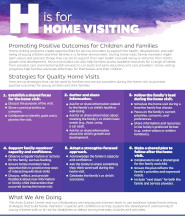A to Z’s of Early Childhood
The Science of Child Development and Learning
H is for Home Visiting
Promoting Positive Outcomes for Children and Families
Home visiting programs create opportunities for service providers to support the health, development, and well-being of young children and their families in a familiar environment. During home visits, family members might learn about and practice things they can do to support their own health and well-being or enhance their child’s growth and development. Service providers can also help families access available resources for a range of needs, from prenatal care and mental health services to car seats and early education and care providers. Home visiting programs help families advocate effectively for themselves and their children.
Strategies for Quality Home Visits
Here are six strategies that can be used by families and service providers during the home visit to promote positive outcomes for young children and their families.
Strategy #1 - Establish a shared focus for the home visit.
- Discuss the purpose of the visit.
- Share current priorities or concerns.
- Collaborate to identify goals and a plan for the visit.
Strategy #2 - Gather and share information.
- Ask for or share information related to the family’s or child’s health or well-being.
- Ask for or share information about meeting the family’s or child’s basic needs (e.g., food, using a car seat).
- Ask for or share information about the child’s growth and development.
Strategy #3 - Follow the family's lead during the home visit.
- Schedule the home visit during a time the family has chosen.
- Focus on the family’s current priorities, concerns, and preferences.
- Share information and resources in the family’s preferred format (e.g., online videos or written handouts).
Strategy #4 - Support family members' capacity and confidence through discussion, reflection, and opportunities to practice new things.
- Observe a regular routine or activity for the family, such as feeding.
- Ensure family members have opportunities to practice new ways of interacting with their child.
- Discuss, reflect, and provide feedback about new information or family-child interactions that occurred during the home visit.
Strategy #5 - Adopt a strengths-focused approach.
- Acknowledge the family’s capacity and confidence.
- Ask the family to share something they think went well during the home visit.
- Celebrate the family’s or child’s successes.
Strategy #6 - Make a shared plan to follow after the home visit.
- Collaborate to set a shared goal for the family and child.
- Ensure the plan reflects the family’s priorities and expressed needs.
- Include “next steps” for both the family and service provider.
What We Are Doing
The Anita Zucker Center and our collaborators are helping practitioners learn to use evidence-based home visiting strategies that build family members’ capacity and confidence as they support the development and learning of young children with or at risk for disabilities or delays during everyday routines and activities.
Learn More:
- Center Members Collaborate with FSU and the Early Steps State Office on Professional Development for Providers
With the help of Early Steps, UF and FSU are collaborating on professional development at three centers in Florida. - Embedded Practices and Interventions with Caregivers
This resource from the Institute of Education Sciences of the U.S. Department of Education provides parents and caregivers with a framework and coaching process to provide early learning opportunities for children with disabilities.
Other Resources
- Family Virtual Home Visiting Guidance
This quick reference guide from Early Steps provides guidance for parents on virtual home visiting. - Provider Virtual Home Visiting Guidance
This quick reference guide from Early Steps provides guidance for providers on virtual home visiting. - National Home Visiting Resource Center
Learn more about different models and providers for home visiting. - Health Resources and Services Administration: Maternal and Child Health Bureau
- Home Visiting Evidence of Effectiveness Review
This review provides information on the effectiveness of home visiting for families. - Early Childhood Home Visiting Programs and Health (Policy Brief)
Learn about the benefits of home visiting for young children and families.
Books and Articles by Center Members and Collaborators
- Salisbury, C., Woods, J., Snyder, P., Moddelmog, K., Mawdsley, H., Romano, M., & Windsor, K. (2018). Caregiver and provider experiences with coaching and embedded intervention. Topics in Early Childhood Special Education, 38(1), 17-29. https://doi.org/10.1177/0271121417708036
- Woods, J., Snyder, P. A., & Salisbury, C. (2018). Embedded practices and intervention with caregivers (EPIC): Linking instruction and family capacity-building recommended practices. In P. A. Snyder & M. L. Hemmeter (Eds.), Instruction: Effective strategies to support engagement, learning, and outcomes: DEC Recommended Practices Monograph Series (No. 4, pp. 145-158). Division for Early Childhood.
- Windsor, K. S., Woods, J., Kaiser, A. P., Snyder, P., & Salisbury, C. (2019). Caregiver-implemented intervention for communication and motor outcomes for infants and toddlers. Topics in Early Childhood Special Education, 39(2), 73-87. https://doi.org/10.1177/0271121418815250
Receive Additional Support
The complete 3R’s of Early Learning downloadable video recordings (including the A to Z’s of Early Childhood) for use in the field of childhood development to facilitate learning are available for purchase.
If you would like to purchase these resources or speak with a member of our team for help in providing professional development, please complete this contact form.

